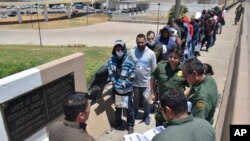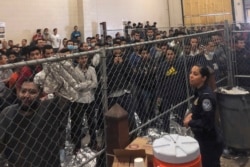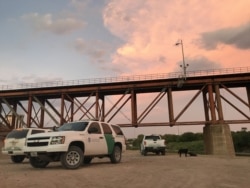VOA's Victoria Macchi contributed to this report.
With the U.S. Supreme Court’s decision this month allowing President Donald Trump’s restrictive asylum policy to go forward, for now, migrants who claim asylum at America's southern border without first seeking protection in another country they transited can be denied.
The de facto ban on border asylum claims is the latest in a series of policy shifts the Trump Administration has implemented during a period of near-record migration from the Americas and beyond. The U.S. Border Patrol reports it has intercepted more than 800,000 migrants and asylum-seekers at the U.S.-Mexico border during the 2019 fiscal year, which ends September 30.
Asylum bans at the US-Mexico border, a brief history
The administration issued the current policy, sometimes referred to as “asylum ban 2.0," on July 16. It followed in the footsteps of an earlier attempt, in November 2018, to deny asylum to any migrant who crossed the border between ports of entry. A federal court blocked the first effort to restrict asylum, and the Supreme Court refused to grant an emergency stay of the injunction.
In short, “asylum ban 1.0” failed to materialize. Migrants were still allowed to present themselves to authorities and request asylum, whether they arrived at a border crossing point or whether they were apprehended after crossing undetected into U.S. territory.
Record apprehensions of migrant family units overwhelmed U.S. Border Patrol's ability to process claims. Detention facilities became severely overcrowded with unprecedented numbers of children. Amid an outcry from lawmakers and human rights advocates, the U.S. government sought multiple avenues to deter migration and reduce detentions on U.S. soil. One of them was the Migrant Protection Protocols (MPP), known as “Remain in Mexico,” first implemented in California in January and later expanded across South Texas.
Under MPP, more than 42,000 migrants seeking asylum at the U.S. southern border were returned to Mexico to await their immigration court hearings. Many found themselves in Mexican border states, like Tamaulipas, for which the U.S. State Department has posted dire travel warnings. Some have given up and boarded buses to southern Mexico. Others have waited in Mexican shelters for weeks or longer, and are pursuing asylum claims in hastily-built U.S. immigration tent courts.
On September 11, the Supreme Court permitted the administration to deny asylum claims to those who did not first seek protection in a country through which they traveled to reach the U.S. southern border.
What’s the case for and against the ban?
One week after the Supreme Court’s ruling, President Trump tweeted an image bearing a message in Spanish: "NO MORE. No more false asylum, no more 'catch and release,' no more illegal entry into the United States."
"Catch and release" refers to a longstanding U.S. policy that, unlike MPP, allows an apprehended migrant to be freed in the United States to await an immigration court hearing months or even years later. On Monday, Acting Homeland Security Secretary Kevin McAleenan announced a formal end to that policy.
In implementing the policy changes, the Trump Administration argued migrants are not entitled to pick their most preferred country in which to seek asylum. Not applying for protection “at the first available opportunity,” the Department of Justice and the Department of Homeland Security wrote in their interim final rule, “raises questions about the validity and urgency of the alien’s claim.”
“Under these circumstances,” the rule stated, “it is reasonable to question whether the aliens genuinely fear persecution or torture, or are simply economic migrants seeking to exploit our overburdened immigration system by filing a meritless asylum claim as a way of entering, remaining, and legally obtaining employment in the United States.”
Except for Mexican nationals, all migrants arriving at America's southern border pass through a third country to get there.
Opponents of the rule argue that it undermines both domestic and international legal obligations, while stripping “fundamental protections from vulnerable individuals fleeing persecution.”
Benjamin Johnson, Executive Director of the American Immigration Lawyers Association (AILA) said, "this rule denies people a meaningful chance to seek asylum, putting the lives of asylum seekers back in the hands of their persecutors, including transnational gangs and cartels.”
What does all this mean for migrants awaiting U.S. court dates in Mexico?
If an asylum-seeker reached the U.S. border after July 16 — when the Trump Administration’s transit asylum bar was published as an interim final rule — the transit rule applies. USCIS issued this guidance on September 12, a day after the Supreme Court’s ruling, BuzzFeed News reported.
Consider the example of a Venezuelan migrant who traveled through Colombia and Panama, then up through Central America and Mexico — a common route. If the migrant reached the U.S. border after July 16, he or she is considered ineligible for asylum under the policy, whether returned to Mexico or not.
The only exception is if the migrant applied for and was denied asylum in a third country en route to the United States. At Laredo, Texas and Nuevo Laredo, Mexico, many migrants recently told VOA they were unaware of the policy when they made their journeys and remained unclear about the asylum process as a whole. Additionally, U.S.-based immigration lawyers report difficulties contacting clients sent to Mexico under MPP. Through the end of August, only 582 out of 38,291 people placed in MPP were represented by a lawyer, or 1.52 percent of cases, according to TRAC data.
Does the new ban effectively eliminate asylum at the southern border?
The Trump administration's restrictive asylum policy will remain in effect pending the outcome of legal challenges in federal courts.
Going forward, the ability of asylum-seekers to obtain protection in the United States is severely limited, but not zero. One possible exception exists for those who can document physical harm if turned away. As Lee Gelernt, a lawyer with the American Civil Liberties Union, told the New Yorker magazine, “the only thing they’ll get when they are brought to the United States is an opportunity to seek ‘withholding of removal’ or relief under the Convention Against Torture.”
Gelernt explained that “withholding, like asylum, protects individuals fleeing persecution. But it is a much harder form of relief to obtain because the standard of proof is very high, and it also doesn’t provide all the benefits of asylum.”
Can a migrant qualify for asylum through other means?
Aside from the southern border region, the ability to claim asylum still exists. For instance, those who fly to the United States and enter on a visa can seek protection if they suffered persecution or feared that they would suffer persecution, if returned, due to race, religion, nationality, political opinion, or membership in a particular social group. USCIS guidelines allow asylum requests within one year of arrival.
At the same time, claiming asylum is no guarantee of being granted protection.
The Trump administration has drastically changed the once-robust U.S. humanitarian relief system for refugees and asylum-seekers, beginning with a series of hotly-contested partial travel bans applying to several majority-Muslim nations. In 2018, the U.S. hit a historic low for refugee arrivals, and that may be repeated this year.
The denial rate for asylum cases has increased, climbing from 42% in 2012 to 65% last year, according to TRAC, a Syracuse University-based research organization. Data suggest the outcome of a case depends heavily on the judge assigned.













